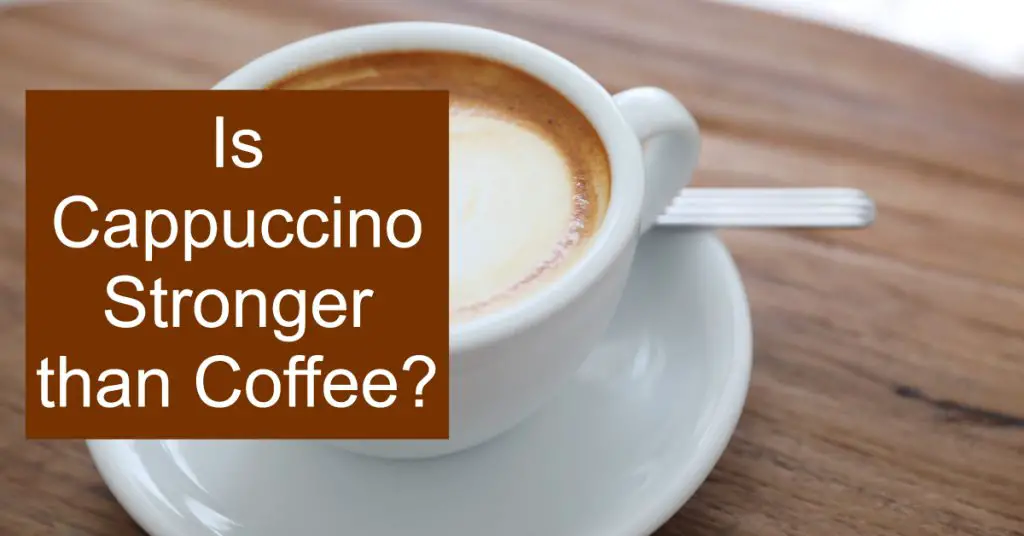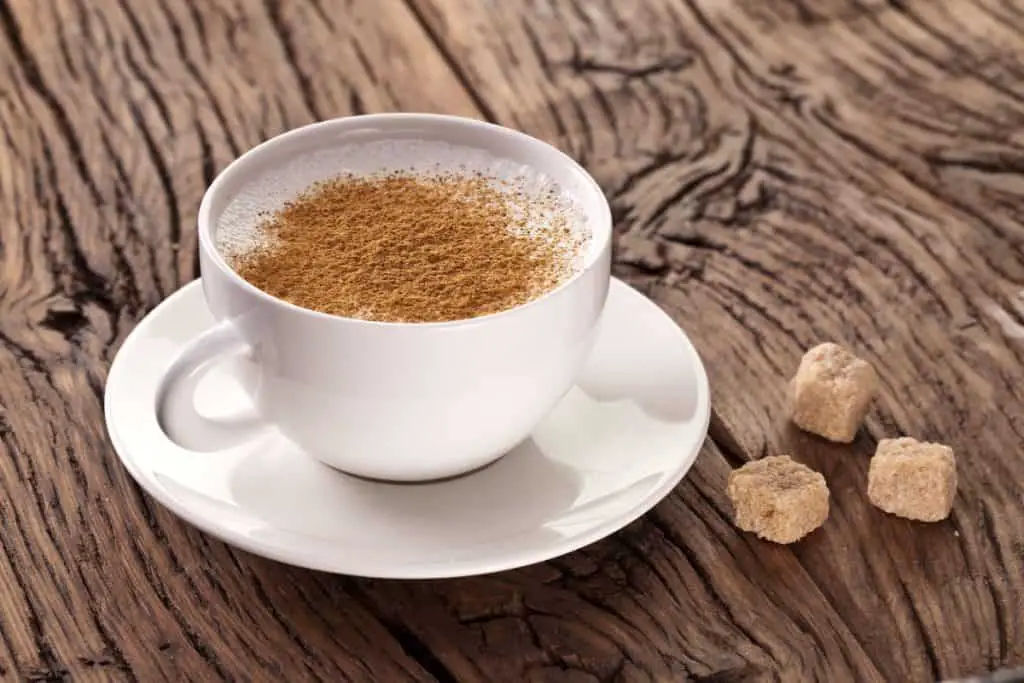Is cappuccino stronger than coffee? This is a question that coffee fans around the world have been trying to answer for ages with seemingly no success. For many java enthusiasts, the debate between what is the “stronger” drink between the two remains open and far from being solved, but worry not avid hot drink connoisseurs; we’re here today to put the argument to rest! From ingredients to preparation and brewing processes, we’re here to break down the answer to the game of cappuccino and coffee: who’s stronger? Read on to find out if you should stick to your regular coffee, or order an extra boost from a cappuccino.

Quick Insight
Generally speaking, cappuccino has more caffeine than coffee because it is made with an espresso shot which is concentrated and contains more caffeine than regular coffee. However, it ultimately depends on how each cup is prepared since the amount of coffee beans and milk can vary.
Comparing Cappuccino & Coffee
Cappuccino and coffee may appear to be similar hot beverages, but they differ in both taste and content. Comparing these two drinks requires analyzing their flavor profiles as well as their composition.
Coffee is made by pouring hot water over ground coffee beans. Depending on the brewing method, brewing time, and bean grind size, this results in a range of tastes from bright and acidic to smooth and chocolate-y. Coffee drinks tend to be light-bodied and liquid-y compared to cappuccinos.
On the other hand, cappuccino is traditionally a combination of espresso (strongly brewed coffee), steamed milk, and milk foam. This combination creates a much richer tasting drink with a creamy texture due to the milk emulsion. On top of that, cappuccino has a more intense flavor than coffee due to its higher espresso concentration.
So while there are similarities between cappuccino and coffee, they can be quite different in terms of flavor profile and composition. To get a better understanding of the difference between these two drinks, it’s important to consider the amount of espresso in each cup — which will be discussed further in the next section.
The Amount of Espresso in Each Cup
When comparing the beverage strengths of cappuccino vs coffee, it is important to consider the amount of espresso in each cup. Generally speaking, a cup of cappuccino contains more espresso than an equal-sized cup of coffee. A standard cappuccino typically includes one to two shots of espresso and more steamed milk and foam than a cup of coffee. Therefore, for those who prefer their drinks stronger, a cappuccino may be the better choice.
On the other hand, there are several varieties of coffee – from light blends to dark roasts – that can be as strong as or even stronger than a cappuccino. Depending on how it’s brewed and the types of beans used, it’s possible for a cup of coffee to contain more espresso than many types of cappuccinos. Some coffee beans are naturally strong enough that they don’t require any extra amounts of espresso added.
Finally, when considering strength, one must take size into consideration as well. For example, a single shot cappuccino is usually smaller than a single shot Americano and will therefore appear less potent.
Ultimately, when determining whether a cup of cappuccino is stronger than a cup of coffee depends on factors such as: what type of beans are used; how much espresso has been added; and the size and style being served.
Are Cappuccinos Stronger than Coffees? The next section will discuss this topic in greater detail.

Are Cappuccinos Stronger than Coffees?
When it comes to the debate of whether cappuccinos are stronger than coffees, the answer can depend on various factors. There are several key differences between a cappuccino and a traditional cup of coffee which can influence the strength of both beverages and lead to varying opinions.
The first difference is that cappuccinos typically contain steamed milk while coffees generally do not. The addition of steamed milk can provide extra creaminess and flavor that may be lacking in coffee but could also water it down, making it less potent than its counterpart. Some coffee drinkers might even argue that the strength of a coffee is actually enhanced without any dairy products, whereas others might argue that adding steamed milk helps give more texture to the beverage.
Another variable is the type of beans used for each drink. For example, an espresso based cappuccino uses more beans than regular drip coffee does, though this does not necessarily mean it will be stronger since some bean roasters might end up with a milder roast. A French press also produces a darker roast than typical desk top brewing machines, yet some people may find this type of beverage strong-tasting regardless of how fine or coarsely ground the beans were initially.
The last distinguishing feature between cappuccinos and coffees is the amount of caffeine each one contains. Here the edge definitely goes to coffee as it has more naturally occurring caffeine than a cappuccino due to its lack of dairy components diluting it down. So if you’re looking for an extra boost in energy, then you’ll likely want to stick with your plain old cup o’ Joe over its foamy cousin.
Overall, it can be difficult to definitively prove whether or not cappuccinos are stronger than coffees since there are so many influences that contribute to the strength of both beverages. Ultimately, however, comparing strength between beverages is something that must be done in order to make an informed decision about which drink best suits your individual needs and preferences.
Comparing Strength Between Beverages
In the debate between coffee and cappuccino, determining which beverage is stronger can be an important deciding factor for those looking for a jolt of caffeine to get them through their day. Understanding the difference between the two beverages is key when it comes to comparing the strength.
Coffee is traditionally known as one of the strongest drinks available. It’s made by dissolving fine-ground coffee beans in hot water, and can contain anywhere from 80-180 milligrams of caffeine per cup. On average, coffee contains approximately 95 mg of caffeine per cup.
Cappuccino is a strong espresso drink that often contains steamed milk with foam on top. Sometimes additives like flavored syrups are used in cappuccinos. Depending on ingredients and recipe, one cup of cappuccino could potentially offer more or less caffeine than a cup of coffee. The amount of caffeine typically ranges from 64 to 100 milligrams per cup, depending on the concentration of espresso used and other added ingredients. Studies show that cappuccino generally contains around 78 mg of caffeine per cup.
If we compare the two beverages across the board, cappuccino usually contains less caffeine per serving than coffee. However, this does not mean that coffee is always stronger than cappuccino because each drink can contain different amounts depending on the type made and individual preferences.
So, who takes the title for stronger between these two popular energy drinks? Ultimately, it depends on where you’re getting your drinks and how much or little caffeine you would like in your beverage. Coffee naturally has higher levels of caffeine but with different servings size and recipes, it’s hard to definitively decide which one truly offers more “strength”. Moving into the next section, let’s explore if either beverage tastes better than another: Is Cappuccino or Coffee Better?
- A standard espresso-based cappuccino contains around 70mg of caffeine, whereas an Americano contains approximately 77mg of caffeine.
- The average cup of brewed coffee contains 95mg of caffeine, while a mug of instant coffee contains around 65mg.
- A large cup of filter coffee typically contains 165mg of caffeine, while a cold brew can contain up to 230mg depending on the method used.
Is Cappuccino or Coffee Better?
When it comes to cappuccino or coffee, there is no definitive answer as to which one is better. It all comes down to personal preference and the particular needs of each individual drinker.
Cappuccino is a creamy and indulgent type of coffee which boasts a prominent espresso taste throughout, this can often be enhanced by the flavoring of steamed and frothed milk, making the brew perfect for those who want a luxurious treat for their morning or afternoon pick-me-up. Coffee on the other hand is more direct, offering a bold espresso taste without any added sweetness from the milk making it easier to detect subtle nuances in the beans that are typically overlooked if using a latte or cappuccino.
The argument between cappuccino and coffee could also be viewed from an accessibilty standpoint. Cappuccinos tend to require skill and precision to craft which is not readily available for all coffee drinkers. Not only do you need a good quality espresso machine, but you must also factor in learning how to make your own steamed and frothed milk foam – something that takes time and practice. Coffee, however, requires far less effort and can be made with simple items such as an Aeropress, French press, or even a regular electric pour over filter.
In conclusion, both types of coffee offer different benefits depending on what you’re looking for when you reach for a cup of joe in the morning. When debating between cappuccino versus coffee it really comes down to personal preference more than anything else.
Looking beyond the caffeine content is the next step towards true java enlightenment. Whether you prefer cappuccino or coffee, learning how it’s produced and where it’s coming from is integral to understanding some of the unique intricacies found within certain brews.

Essential Summary Points
Cappuccino and coffee have different flavor and accessibility benefits, so it ultimately comes down to personal preference when choosing which one to drink. Cappuccinos are creamy, indulgent and have a bold espresso taste enhanced by milk, whereas coffee offers a direct espresso taste without added sweetness from milk. Coffee can be made with simple tools like an aeropress or French press, while cappuccinos require consistency and skill on the part of the drinker. To become an even better coffee enthusiast, it’s important to explore the origins and process of making different types of coffee.
Looking Beyond the Caffeine
Coffee and cappuccino share much more than just caffeine in terms of their makeup. Both drinks derive their flavor profiles through various factors, such as roast level, origin, bean type and brewing method. This means that one cup of coffee made with light roasted beans might be very different in taste from the same cup brewed with dark roast. The same applies to cappuccino – a foamier drink made with whole milk can have a much richer flavor than one made with nonfat milk or soy milk.
Another key difference between coffee and cappuccino is that coffee is typically devoid of any sweetness, while cappuccino often has added sugar or syrup for sweetness. Those who want a stronger, bitterer cup of coffee can opt for an espresso instead – a concentrated form of coffee brewed at extremely high temperatures – which can provide more kick than regular drip-brewed coffee.
The choice between these two beloved beverages ultimately comes down to personal preference rather than strength. Some may find the taste of cappuccino too sweet and may prefer the bitterness of coffee instead. Likewise, those who favor creamier tastes might be drawn to a cappuccino over a black cup of joe.
Moving beyond caffeine levels and personal preference, it’s also important to consider the health benefits offered by these drinks. Coffee has been known to help improve mental alertness, potentially reduce the risk of stroke and decrease fatigue—whereas cappuccino boasts similar mental benefits while providing an added source of calcium through dairy milk consumption.
As we explore the nuances of both coffees and cappuccinos, let’s now compare flavor profiles to better understand which beverage offers the best taste experience.
A Comparison of Flavor Profiles
When it comes to comparing the flavor profiles of coffee and cappuccino, each drink offers its own distinct notes. Coffee often has a fuller-bodied flavor that can range from mild and nutty to deep, bitter tones depending on the beans used in the blend. Cappuccino is made by combining espresso with steamed milk and a layer of foam on top, resulting in a stronger flavor profile than coffee – the type of flavor notes depend on the blend of espresso beans used.
While some people may prefer the smoother flavor of cappuccino over the intense flavors found in coffee, others may feel that cappuccino is too heavy and acidic for their taste. It all comes down to individual preference when deciding which one tastes better. However, both drinks can be made with decaffeinated varieties for those seeking a lighter caffeine option.
Regardless of individual preference, it is clear that coffee and cappuccino offer different flavor profiles, ranging from bold and intense to smooth and creamy. This ends our comparison of flavor profiles, so let’s move on to explore the next aspect: which drink satisfies your caffeine needs?
Which Satisfies Your Caffeine Needs?
When it comes to satisfying your caffeine needs, deciding between coffee and cappuccino can be a tough choice. As discussed earlier, both beverages have similar levels of caffeine; however, due to the added milk and froth, cappuccino is often seen as the weaker option.
On one hand, for those who prefer a more robust flavor with a high level of caffeine, a cup of regular coffee might be the preferred option. Coffee typically contains an average of 95 mg of caffeine per 8 Oz cup. It provides an almost instantaneous pick-me-up and is somewhat acidic in taste. However, if you’re looking for a less intense flavor without sacrificing on your desired daily amount of caffeine intake, then cappuccino might be the better option. On average, a cup of cappuccino contains 64mg of caffeine per 8 Oz cup which still offers enough kick for most people. Cappuccino also offers a creamy sweetness and smoother flavor profile compared to coffee due to the added milk and sugar.
Ultimately, when it comes to choosing between coffee or cappuccino based on your desired caffeine needs, it really depends on your individual preference. Both drinks offer similar levels of caffeine and satisfy even the most avid of drinkers. While coffee might offer a stronger, more acidic flavor profile with higher levels of caffeine, cappuccino provides a sweeter, more delicate flavor that still packs enough punch for a midday lift. So no matter which you choose, either way you’ll be able to meet your daily dose of caffeine requirements with ease!
Answers to Common Questions
Is it possible to adjust the strength of cappuccino?
Yes, it is possible to adjust the strength of cappuccino. You can choose a variety of coffee beans, grinds, and roasts that yield different levels of strength. For example, a bold roast offers higher caffeine content than a light roast. Additionally, using espresso as the base for cappuccino will result in stronger drinks than if you used brewed coffee. By controlling variables such as quantity and type of crema foam you use, you can also adjust the strength of the blended drink. Therefore, cappuccino can be altered to suit your desired levels of strength.
How does the strength of cappuccino compare to other types of coffee drinks?
Cappuccino is usually stronger than other types of coffee drinks because it contains a higher ratio of espresso to steamed milk. The liquid base of cappuccino is usually 1-2 ounces of concentrated espresso; for comparison, a latte typically has only 1-1.5 ounces. Additionally, the amount of steamed (or frothed) milk in a cappuccino is much less than what you would find in a latte, with it often equal parts espresso and steamed milk. This contributes to the strong flavor of cappuccino versus other coffee drinks that are predominantly dairy-based.
The unique combination of flavors and ingredients gives cappuccinos its signature flavor and intense caffeine content that intrigues coffee lovers from all over the world. It’s no wonder why so many people are drawn to this classic espresso drink!
What ingredients are used to make cappuccino that impact its strength?
Cappuccino is typically made up of three main ingredients that can affect its strength: espresso, steamed milk, and foam.
The espresso used in cappuccino is what gives it its strong flavor and kick. When strong espresso beans are used, a stronger cappuccino will be produced. The quality, blend and roast of the beans all ultimately determine how strong the beverage will be.
The second major ingredient found in cappuccino is steamed milk, which adds the creamy texture to the drink. Longer steaming times can produce milk with higher concentrations of proteins and fats, resulting in a richer and thicker texture that adds substance to the drink. Pouring more steamed milk into the drink makes your cappuccino less strong by diluting it further.
Finally, foam also plays an important role in impact cappuccino strength because it also helps thicken and bind the other ingredients together when added on top. The amount of time that you steam your milk also affects how much foam there is–so if you’re looking for a weaker cappuccino then you’ll want to steam for a shorter amount of time for less foam. If a stronger cappuccino is desired then longer steaming times will yield more foam-packed drinks.
Overall, by choosing strong espressos, steaming long enough to create dense milk foam and adding enough foam each time, you can create an incredibly strong and delicious cup of cappuccino!

